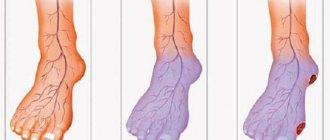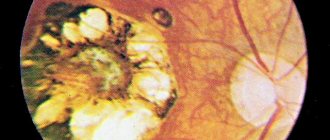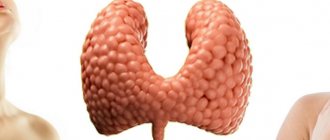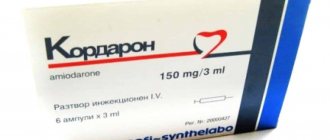What is hypothyroidism?
The content of the article
The thyroid gland is the organ responsible for producing hormones that control metabolism, such as triiodothyronine (T3), thyroxine (T4) and calcitonin. To produce them, the thyroid gland needs iodine from food and air. The functioning of the thyroid gland is controlled by the hormone TSH, which is produced by the pituitary gland.
Hypothyroidism is a group of symptoms caused by a lack of hormones produced by the thyroid gland. Women are more likely to be affected—hypothyroidism is estimated to affect 5% of women and 1% of men. 1-6% of patients are under 60 years of age, and its incidence increases with age.
References
- Francois, M., Baigent, C., Catapano, A. et al. 2021 ESC/EAS Guidelines for the management of dyslipidaemias: lipid modification to reduce cardiovascular risk, 2021. - Vol. 41(1). — P. 111-188.
- Arthur, C., John.E. Physiology Review, 2015. - ISBN: 9781455770076.
- Severin, E.S., Aleynikova, T.L., Osipov, E.V. and others - M.: Medical Information Agency LLC, 2008. - 364 p.
- Kumar, V., Abbas, A., Fausto, N. et al. Robbins and Cotran Pathologic basis of disease, Fundamentals of the pathology of diseases according to Robbins and Cotran / trans. from English; edited by E.A. Kogan. In 3 volumes. Volume 1: chapters 1–10. - M.: Logosfera, 2014. - 624 pp.; ill.; 21.6 cm. - Translation ed. Robbins and Cotran Pathologic Basis of Disease, Vinay Kumar, et al., 8th ed. — ISBN 978-5-98657-052-5.
Symptoms of hypothyroidism
Most often, hypothyroidism is associated with weight gain, but the list of typical ailments is much longer. Clinical symptoms of thyroid hormone deficiency can be more or less severe, but thyroid hormones affect the function of almost all tissues and organs of the human body.
The symptoms of hypothyroidism are so varied that they are often associated with other diseases, such as dermatological, gastrological, cardiac or hematological. This is why a deficiency of thyroid hormones, called hypothyroidism, can cause a number of seemingly unrelated symptoms.
The doctor is most often contacted with the following complaints:
- constant fatigue;
- drowsiness that does not go away despite drinking large amounts of coffee or energy drinks;
- problems with concentration and memory;
- muscle weakness;
- chronic constipation;
- mood swings - depression, apathy and tendency to depression;
- feeling cold - even in warm clothes or in heated rooms;
- eye pain, redness and burning - symptoms often reminiscent of conjunctivitis;
- decreased immunity - the result of frequent infections;
- problems with pregnancy.
Low hormone levels can also affect your appearance, causing: hair loss, pale and dry skin, puffiness.
If you notice that your neck circumference has increased for unknown reasons, contact your endocrinologist and ask for a referral for a thyroid examination.
People with mild hypothyroidism may not notice any symptoms at first, but if the problem is not detected and treated promptly, the disease can develop quite quickly.
Tests to check your thyroid gland
Even if you feel great, have your thyroid checked at least once every 2-3 years (and every year after age 50). This is mandatory if you are planning to become pregnant or are already pregnant, and if you have any of the above symptoms.
Basic diagnosis involves checking the blood for levels of a hormone produced by the pituitary gland, i.e. TSH levels. If there is too much of it, it is a sign that the body is trying to stimulate the thyroid gland more intensely. And this happens precisely because the thyroid gland does not produce enough of its own hormones.
TSH values
Parameters may vary depending on the laboratory, but there are certain standards. Acceptable TSH values are usually between 0.4 and 6.0 mIU/L.
The result must be assessed individually (only a doctor can do this) since, for example, in older people, exceeding the upper limit may still be the norm.
However, in the case of women trying to have a baby, the optimal TSH level is 1 mIU/L, which is higher than 2.5 mIU/L - although it seems normal. In this case, treatment for hypothyroidism may already be required!
The second important point is the reliability of a single result. Many factors affect TSH levels. It can be reduced artificially, such as by fasting or certain medications (such as steroids). Therefore, if you have symptoms typical of hypothyroidism despite a normal TSH level (and these cannot be explained by another disease), you may be dealing with subclinical hypothyroidism. In this case, it is worth repeating the test, for example, after three months.
Or the current diagnostics should be expanded to include:
- checking the level of thyroxine produced by the thyroid gland (FT3, normal: 2.0–4.0 ng/ml and FT4, normal: 0.7–2.25 ng/100 ml; a result below normal indicates hypothyroidism),
- ultrasound of the thyroid gland - when diagnosing hypothyroidism, it helps to assess whether the gland is damaged, for example, due to inflammation,
- checking the amount of antibodies to the thyroid gland in the blood - a significant excess of the norm indicates inflammation of the thyroid gland, which occurs, for example, with Hashimoto's disease.
It is known that hypothyroidism is caused by a persistent decrease in the effect of thyroid hormones on target tissues, which is associated with a lack of thyroid hormones in the body or a decrease in their biological effect at the tissue level [3, 4]. Thyroxine (T4) and triiodothyronine (T3) secreted by the thyroid gland regulate protein synthesis and influence the metabolic and functional activity of nervous system structures [8]. The key component of thyroid hormones is iodine. The synthesis of thyroid hormones is regulated by thyroid-stimulating hormone (TSH), which is synthesized in the anterior pituitary gland. The formation of TSH decreases under the influence of glucocorticoids and increases under the influence of estrogens. The level of TSH is regulated by the structures of the hypothalamus with the participation of somatostatin and dopamine. It is subject to circadian fluctuations and can change under the influence of environmental factors, such as ambient temperature. The inhibitory effect is realized under the influence of the serotonergic system of the brain. TSH is present in many parts of the central nervous system and itself has the ability to inhibit the bioelectrical activity of neurons.
Hypothyroidism occurs in the population in 0.2-2% of cases, among the elderly - in 2-4%, and in women 3 times more often than in men [3, 4, 16]. Women aged 40-60 years are especially susceptible to this disease; the prevalence rate among women in the older age group reaches 12% [3]. Subclinical hypothyroidism (increased TSH levels without any clinical symptoms) is observed in 7.5-10% of women and 3% of men [3, 8, 23].
Hypothyroidism can be caused by various reasons: congenital changes in the thyroid gland (hypo- or aplasia), its surgical removal, pituitary dysfunction. However, in adults it is more often a consequence of autoimmune processes. Chronic autoimmune thyroiditis occurs in 3-4.5% of individuals in the general population. The biosynthesis of thyroid hormones is disrupted by drugs such as amiodarone, sulfonamides, and lithium preparations [15]. Sometimes hypothyroidism is accompanied by other endocrine disorders.
In a significant proportion of cases, hypothyroidism is associated with iodine deficiency. WHO recommends a daily iodine intake of 150 mcg for adults, 200 mcg for pregnant and lactating women, and 50 to 120 mcg for children. With a daily iodine intake of less than 50 mcg, the thyroid gland begins to produce less hormones than required, which is clinically manifested as hypothyroidism. Almost one billion people worldwide are thought to be at risk of developing iodine deficiency disorders [17]; Almost 13% of the population has iodine deficiency [15]. These are mainly countries in Asia and Africa, where there is no iodine in water and food or its consumption in the form of iodized salt is insufficient [15]. In areas where there is iodine deficiency, the incidence of hypothyroidism is 10-20 times higher.
Pathogenesis
The pathogenesis of clinical disorders in hypothyroidism is based on metabolic disorders caused by a sharp decrease in the production of a number of cellular enzymes due to a deficiency of thyroid hormones [3, 15]. This leads to a decrease in metabolic processes and a slowdown in redox reactions. In this case, mucinous edema (myxedema) of the tissue develops [3]. Disturbances in the metabolism of glycosaminoglycans, which have increased hydrophilicity of protein breakdown products (protein derivatives, glucuronic and chondroitinsulfuric acids), lead to infiltration of the mucous membranes, skin and subcutaneous tissue, muscles, and myocardium [3]. Cerebral hypoxia occurs, contributing to the development of episodes of confusion and syncope. In the pathogenesis of cognitive disorders in this category of patients, certain importance is attached to neurotransmitter disorders, caused, in particular, by the influence of thyroid hormones on the acetylcholinergic system [10, 22]. In this regard, it should be noted that thyroid pathology is detected in 38% of patients with frontotemporal dementia, and hypothyroidism is a risk factor for the development of Alzheimer’s disease [22]. Even in a euthyroid state, in clinically healthy older adults, there is a relationship between lower levels of thyroid hormones (within normal values) and decreased cognitive function. Reduced cerebral blood flow, cerebral hypoxia, cerebral edema and hyponatremia are also of pathogenetic significance. The influence of thyroid hormones on electrolytes and blood pressure occurs through the reticular activating system [15]. Even a slight decrease in the level of thyroid hormones in the blood can lead to severe cognitive impairment [15].
Thyroid hormones play a very important role in the development of the nervous system. In particular, when they are deficient during pregnancy, the development of the nervous system in the fetus is disrupted, which is manifested by cortical hypoplasia, delayed myelination processes and slowed formation of cerebral vessels. If hypothyroidism is not corrected in the early postnatal period, these changes become irreversible. However, if hypothyroidism occurs in adults, then changes in the nervous system are less pronounced and usually reverse with treatment.
Clinical manifestations
The most common clinical manifestations of hypothyroidism are increased fatigue, general weakness, drowsiness, decreased appetite, weight gain, hypomia, and impaired tolerance to low ambient temperatures [3, 8, 16]. Patients often complain of constipation, muscle and joint pain, especially headaches (it should be noted that headaches in these cases often disappear with adequate hormone replacement therapy for hypothyroidism).
The listed symptoms of hypothyroidism are very nonspecific. In this regard, hypothyroidism is often diagnosed months and even years after the onset of its first symptoms [8]. Signs such as weight gain (even against the background of decreased appetite), baldness and slowness of movement are often taken as signs of “normal” aging, and hypomimia is a manifestation of depression or parkinsonism. Since depression can develop with hypothyroidism, diagnostic errors regarding this form of affective disorders become less obvious [5]. In addition, according to some data, subclinical hypothyroidism is often detected in patients with depression [5]. It has therefore been suggested [5] that thyroid function testing is mandatory in any depressed patient who does not respond to antidepressant therapy.
In patients with hypothyroidism, sweating decreases and the skin becomes dry. The hair on the body changes until it is completely lost, especially in the pubic area and in the outer third of the eyebrows. There is swelling of the hands and feet. The appearance of patients changes, which is largely due to swelling of the eyelids and face. Hoarseness and articulation disorders are quite characteristic, which is caused by infiltration of glycosaminoglycan into the vocal cords and tongue. The pulse often drops to 60 beats per minute or less. There may be an expansion of the borders of the heart, but heart failure rarely develops. Echocardiography may reveal pericardial effusion. Against this background, aggravation (or occurrence) of pain such as angina pectoris may occur. Hypercholesterolemia, characteristic of hypothyroidism, increases the risk of developing vascular diseases. With hypothyroidism, women often experience heavy periods and infertility.
Neurological and mental disorders, which have been known since the end of the 19th century, range from mild disorders of higher cerebral functions, peripheral myoneuropathy and pathology of the cranial nerves to psychoses, ataxia, paroxysmal disturbances of consciousness (syncope, epileptic seizures) and coma [1, 5, 8] .
Hypothyroidism may not be accompanied by neurological symptoms for several years. The development of neurological disorders is characterized by an insidious onset and slow progression [25]. In these cases, the presence of increased fatigue and drowsiness often does not attract the proper attention of either the doctor, the patient himself or people close to him and relatives.
In some cases, the disease begins acutely with the onset of seizures. At one stage or another of the disease, they are observed in 20-25% of patients with hypothyroidism [5]. It is important to note that anticonvulsants do not lead to thyroid dysfunction [5]. A rare debut of hypothyroidism is acute psychosis, occurring with visual and auditory hallucinations. It is believed that hypothyroidism as a cause of the disease should be taken into account when making a differential diagnosis in any patient with sudden onset mental disorders, depression or hallucinations [15].
With untreated hypothyroidism, in approximately 1% of cases, a coma quickly develops (often accompanied by epileptic seizures). In these cases, in addition to hypothermia, arterial hypotension, bradycardia and rare breathing are noted [5]; the prognosis is often unfavorable, with the cause of death in most cases being cardiac arrhythmia. Pathomorphological examination reveals only severe cerebral edema, and in the most severe cases, diffuse neuronal damage [5]. Older women are most susceptible to developing a coma during the winter season [15].
For patients with hypothyroidism, vestibuloatactic disorders are quite common [1, 4]. Cerebellar dysfunction occurs in 5-10% of patients [5, 16]. Most often, it manifests itself as gait disturbances in the form of a gait with legs wide apart, tandem walking is impaired, and patients often experience impaired coordination in the limbs, tremor, dysarthria and nystagmus. The basis of such disorders is probably atrophy of the anterior parts of the cerebellar vermis, which, however, (with adequate therapy) is reversible [5].
Neuromuscular disorders in the form of neuropathies and dysmetabolic myopathy are very characteristic disorders of hypothyroidism and occur in 30-80% of patients (differences in the figures given depend on the severity of hypothyroidism). With therapy, these disorders may regress. The main manifestation of hypothyroid myopathy is a slowdown in muscle contraction and relaxation. Microscopic examination of the muscles reveals local necrosis of muscle fibers and basophilic degeneration of skeletal muscles. In rare cases, muscle hypertrophies are detected, reminiscent of those in Hoffman syndrome. Severe muscle weakness is rare, but mild disorders are observed in almost 40% of cases [12]. The proximal limbs are most often affected [19, 20]. Myopathic syndrome in hypothyroidism can occur with both muscle atrophy and hypertrophy [4]. The severity of muscle weakness increases at low temperatures. However, much more often, patients experience muscle cramps, pain and paresthesia, usually in the proximal limbs, as well as reduced tolerance to physical activity [14, 16]. There is also a description in the literature [6] of “treatable dropped head syndrome” in hypothyroidism, as well as myopathy in acute hypothyroidism (with its development within 2-6 weeks) [18]. In the blood serum of patients with hypothyroid myopathy, increased levels of creatine phosphokinase (CPK) may be detected [4, 14, 16]. This is especially typical for cases occurring with muscle weakness in the proximal extremities, however, no correlation of increased CPK with the severity of muscle weakness was noted [12].
In some cases, patients with hypothyroidism may exhibit myasthenic syndrome with corresponding changes in the EMG.
An association between hypothyroidism and fibromyalgia has been noted [26]. It has been suggested that fibromyalgia is a form of hormone-resistant hypothyroidism. However, it should be noted that during therapy for hypothyroidism, there is a decrease in the severity of pain caused by fibromyalgia.
The presence of hypothyroidism is an important factor in the development of dystrophic changes in the spine, which is associated with impaired synthesis of collagen, which is part of the disc structure [4]. Therefore, for this category of patients, it is quite typical to have pain in various parts of the spine, impaired mobility, pain in the spinous processes and paravertebral points, and the occurrence of tension symptoms [4].
Damage to peripheral nerves is one of the characteristic manifestations of hypothyroidism [2, 16, 17]. In this case, damage to sensory fibers develops at earlier stages of the disease, when there are no changes in the propagation of excitation along motor fibers [11], however, there is evidence indicating a more frequent involvement of motor fibers in the pathological process [13]. The most common (14-81% of patients) complaint is paresthesia [17]. Paresthesia may be based on tunnel syndrome (for example, carpal tunnel syndrome), the presence of which is noted in 70% of patients [4]. Its development is associated with the deposition of mucopolysaccharides in the skin and around peripheral nerves [5]. A significant decrease in axonal regeneration in conditions of thyroid hormone deficiency may also be important [4]. The most common tunnel syndrome in hypothyroidism is carpal tunnel syndrome - in 10-35% of patients [5, 12, 16]. As a rule, it is bilateral in nature. However, in clinical practice there may be situations when existing disorders on one side do not manifest clinical symptoms [5]. A feature of tunnel neuropathies is their multiple, combined nature [4].
One of the typical manifestations of nervous system pathology in hypothyroidism is also demyelinating polyneuropathy [16]. Polyneuropathy caused by hypothyroidism is characterized by a decrease in reflexes and the development of muscle weakness; in addition, patients may experience a decrease in vibration sensitivity and muscle-joint sense. According to electron microscopy, there are ultrastructural changes in the endoneurial vessels [9]. Damage to peripheral nerves can be detected by electromyography even in patients without neurological symptoms [13]. Changes caused by segmental demyelination are manifested by a decrease in the speed of propagation of excitation along the nerve fiber. In this case, damage to peripheral nerves can be observed even with subclinical hypothyroidism [17]. Under the influence of hormone replacement therapy, the corresponding symptoms may undergo reverse development. Experimental studies [24] have established a positive effect of thyroid hormones on the condition of nerve fibers and the regeneration of nerve tissue.
The pathogenesis of peripheral (including cranial) neuropathies, in addition to compression, is based on other factors, including microcirculation disorders and metabolic neuronal disorders. Sensorimotor axonal polyneuropathy occurs in 40-90% of patients [4, 12].
Pyramidal symptoms occur rarely, but decreased deep reflexes are one of the characteristic (in 85% of patients) signs of hypothyroidism. Despite the normal process of muscle contraction, there is a significant prolongation of the muscle relaxation phase [5, 8]. This phenomenon is detected in more than 2/3 of patients with hypothyroidism. It should be noted that similar changes can occur with hypothermia, edema of the extremities, diabetes mellitus, parkinsonism, neurosyphilis, sarcoidosis and pernicious anemia. In hypothyroidism, reflexes are normalized with hormone replacement therapy.
Hypothyroidism can also cause damage to the II, V, VII, VIII pairs of cranial nerves [5]. Quite often various ophthalmological disorders develop. Thus, with primary hypothyroidism, there may be loss of visual fields due to an enlargement of the pituitary gland. It is possible to develop pseudotumor, leading to swelling of the optic discs. This syndrome mainly occurs in children a few weeks after the start of hormone replacement therapy, but similar cases have been described in adults [5]. Rare manifestations include uveitis and ptosis. With hypothyroidism, typical and atypical trigeminal neuralgia is sometimes detected. Peripheral facial paresis may also develop. There is evidence [5] about damage to the VIII pair of cranial nerves (although some researchers do not confirm this). Tinnitus and hearing loss, probably caused by damage to the cochlea, may regress with therapy. Patients with hypothyroidism receiving L-thyroxine may also experience a decrease in taste, accompanied by a burning sensation in the mouth [5].
Cognitive and mental disorders can vary from slow mental functions and mild mnestic disorders (in some cases resembling the initial manifestations of Alzheimer's disease) to severe psychotic disorders occurring with illusions and hallucinations [5]. In severe cases, patients become apathetic, the speed of mental processes decreases sharply, and speech slows down. In the neuropsychological status, in addition to memory and attention disorders, disorders of constructive praxis and visual-spatial functions are revealed. This category of patients is characterized by sleep apnea, both central and peripheral, and in the second case, improvement can be obtained with hormone replacement therapy [4, 5].
Cretinism, a term that was proposed at the beginning of the 19th century. to designate severe encephalopathy in hypothyroidism, develops when pathology occurs in early childhood (even from the moment of birth). In these cases, we are usually talking about congenital absence of the thyroid gland, congenital metabolic disorders, iodine deficiency during pregnancy and in the early postpartum period. However, the onset of clinical symptoms can be “delayed” by hormones received from the mother. It should be noted that the prevalence of congenital hypothyroidism has decreased significantly due to the introduction into clinical practice of appropriate methods of early diagnosis and adequate therapy [15]. However, studies in adolescents, even after correctly and actively treated congenital hypothyroidism, report impairments in memory, attention, and visuospatial functions [15].
Mild cases of iodine deficiency encephalopathy currently occur in almost 50 million children worldwide, resulting in an average reduction in IQ of 15 points [15]. In the cognitive sphere, this category of patients exhibits memory and attention impairments, apathy, drowsiness, depression, as well as behavioral disorders [15]. Selenium deficiency, which accompanies iodine deficiency, also plays a role in the pathogenesis of neurological disorders in cretinism. In patients with cretinism, in addition to mental retardation, a decrease in body weight, pathology of dental development, thinning of the tongue, a protruding abdominal wall (usually with the presence of an umbilical hernia) and bone abnormalities are usually detected. The neurological status also often reveals deafness, pyramidal and sometimes extrapyramidal symptoms, and strabismus. Pyramidal symptoms in the form of muscle rigidity are more often detected in the lower extremities, and revitalization of knee reflexes is often noted. Unfortunately, therapy for already developed cretinism with neurological disorders is ineffective. Therefore, it is so important to start hormonal treatment immediately after the birth of a child with signs of hypothyroidism or if the possibility of its development is suspected.
In patients with hypothyroidism, an increase in gamma globulins in the blood serum and cerebrospinal fluid (CSF) is often detected, and in 40-90% of patients there is an increase in total protein in it. CSF pressure is usually not elevated in hypothyroidism. According to the EEG, there is a decrease in -activity. X-ray or magnetic resonance computed tomography (CT or MRI) of the brain shows mild cerebral atrophy. In hypothyroidism associated with an autoimmune process, reversible diffuse changes in the white matter of the cerebral hemispheres can also be detected [15].
Diagnostics
Diagnosis of hypothyroidism is carried out on the basis of anamnestic data, the results of a clinical study and the identification of a low free thyroxine index, the identification of primary hypothyroidism is based on the determination of an elevated TSH level. Secondary (associated with pituitary dysfunction) and tertiary (associated with hypothalamic dysfunction) hypothyroidism is characterized by the presence of a low level of TSH in combination with low levels of T3 and T4.
Making a differential diagnosis between secondary and tertiary hypothyroidism is challenging and not always possible. For this purpose, a thyroid-releasing stimulation test is used - intravenous administration of 400 mcg of thyroid-releasing hormone with determination of the level of TSH in the blood serum initially and 30 and 60 minutes after administration. Normally, the TSH level increases 2 times compared to the original level. This indicates normal functioning of the pituitary gland and allows one to suspect hypothalamic dysfunction as the cause of hypothyroidism. Another method that helps in the differential diagnosis of these two conditions is an MRI of the brain with a detailed assessment of the pituitary gland and hypothalamus.
Prevention and treatment
Prevention of hypothyroidism in areas with iodine deficiency involves adding iodine to food, in particular in the form of iodized salt [15]. To treat hypothyroidism, L-thyroxine and, in some cases, oral triiodothyronine are used. In most cases, adults require 100 to 150 mcg of L-thyroxine per day; To treat coma, L-thyroxine is administered parenterally [15].
Treatment begins with small doses of the drug and gradually increases over the course of months, achieving a euthyroid state [15]. It should be noted that the effectiveness of such therapy in the presence of severe neuromuscular disorders in patients with hypothyroidism is significantly lower than in patients with thyrotoxicosis [12]. With adequate treatment of hypothyroidism, patients may experience positive changes in the cognitive sphere [7, 21]. Therefore, dementia in patients with hypothyroidism is considered a potentially reversible condition (although relevant epidemiological and placebo-controlled clinical studies have not been conducted) [25].
Hypothyroidism: treatment
Therapy is based on oral administration of synthetic hormones.
- Endocrinologists usually prescribe large doses to young people. Over time, they reduce them to the necessary minimum.
- In elderly patients, the procedure is the opposite - the doctor first recommends a small dose of the hormone and, if necessary, gradually increases it.
Thyroid medications are taken for a long time, often for the rest of your life.
Fortunately, the therapy gives good results - most of the symptoms caused by hypothyroidism disappear and do not cause side effects.
It is very important to receive appropriate treatment, as the consequences of an untreated disease can be dangerous to your health. The consequences of severe hypothyroidism can include heart disease, infertility, depression and, in very severe cases, even life-threatening neurological disorders and hypometabolic coma.
About cholesterol
Cholesterol is found in every cell of your body. Your body uses it to produce hormones and substances that help digest food.
Cholesterol also circulates in your blood. It enters the bloodstream in two forms of lipoproteins:
- High-density lipoprotein (HDL) cholesterol is good for your heart. They help remove cholesterol from the body and protect against heart disease.
- Low-density lipoprotein (LDL) cholesterol is bad for your heart. If LDL cholesterol levels are too high, the cholesterol can clog arteries and contribute to heart disease, heart attacks and strokes.
Diet is important
Pharmacotherapy should be supplemented with natural methods. Staying at sea helps with hypothyroidism, because there is a lot of iodine in the air.
This element is needed for the proper functioning of the thyroid gland. It is because of iodine that people with hypothyroidism are advised to consume iodized salt or take iodine supplements. But be careful! The latter can be taken only after consultation with a doctor.
The diet for hypothyroidism should first of all be varied.
If you are overweight, watch your caloric intake (1500–1800 kcal per day), but do not completely reduce your carbohydrate intake.
Important rules:
- eat vegetables, fruits, legumes and wholemeal bread - the fiber they contain will help cope with constipation,
- regularly eat sea fish - it is a source of iodine and polyunsaturated fatty acids (they reduce the level of bad cholesterol),
- limit your consumption of animal fats (butter, fatty meats) - they contain a lot of cholesterol.
Sick thyroid gland and pregnancy
Although hypothyroidism most often occurs during menopause, it can affect women of any age, especially during the hormonal storms associated with puberty and pregnancy.
Problems with the thyroid gland can make it difficult to get pregnant or contribute to miscarriage. The correct concentration of thyroid hormones is extremely important for the proper development of the fetus. It is the thyroid hormones that influence the formation of the brain, development of the teeth and skeleton of the unborn child. Therefore, pregnant women with hypothyroidism should be under constant supervision of an endocrinologist.
Complexes with this research
Female infertility Analysis of the state of women's reproductive health 16,470 ₽ Composition
Biomarkers of the functional capacity of the liver. Extended examination 3,990 ₽ Composition
Pregnancy planning. Clinical indicators 6,800 ₽ Composition
IN OTHER COMPLEXES
- Diabetes monitoring RUB 1,900
- Liver and pancreas RUB 3,130
- Biochemistry of blood. 8 indicators 990 ₽
- Examination during pregnancy. 1st trimester 17,040 RUR
- Men's check-up No. 1 RUB 18,920







